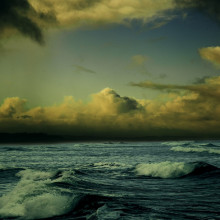QotW: Will climate change affect monsoons?
Saugat asked "what is the exact cause of monsoon rain, and how will it be affected because of global warming?" Ruth Geen, from the University of Exeter, works with modelling the effect of climate change on monsoons and helped Emma Hildyard pour some insight into this...
In this episode

00:00 - QotW: Why do monsoons occur?
QotW: Why do monsoons occur?
It’s time for Question of the Week, and Emma Hildyard has been on the hunt for an answer to this monsoon question from Saugat...
Emma - Ruth Geen, from the University of Exeter helped us with this.
Ruth - This year we’ve seen some strong monsoon rains in parts of South Asia, which have caused these terrible floods.
Emma - Britain is well known for its rain - but we don’t get the big tropical storms that are typical during monsoon seasons over the land of the tropics - Why is this?
Ruth - It’s all to do with the latitude that we live at. The main driver of the monsoons is the sun. In the tropics, the sun is almost directly overhead in summer. This heats up the ground of the Earth, and the air above it. This hot air begins to rise and the atmospheric pressure over the warmed region falls. The pressure difference between the hotter air - over the land - and cooler air - over the ocean - causes the prevailing wind direction to blow towards the land.
Emma - When the humid air meets the hot air, the water vapour begins to condense and releases rain.
Ruth - The amount of monsoon rain that falls varies from year to year, and this depends on a mix of different factors, like sea surface temperatures in the Pacific and Indian Oceans.
Emma - The amount of rain, and where it falls, varies within a given season too. This is affected by 'intra-seasonal oscillations’, such as the Madden-Julian oscillation, which are waves of moister and drier air that travel through the tropics. So there’s a lot going on that can contribute to events like this year.
Ruth - Over the 21st century, climate models suggest that monsoon rainfall over South Asia will increase, perhaps by around 5-10% - though it’s worth noting that there is a spread in what the models predict, some suggest more than this, some less.
The monsoon rains over South Asia are fed by warm, humid air from the Indian Ocean. Climate change is causing the temperature of the air to gradually increase, and warmer air can hold more water vapour.
Emma - This more humid air is expected to cause more rainfall during monsoon season over the land of South Asia.
Ruth - If a larger volume of rain falls over a given period than can be drained to rivers, or than the river can carry, then this causes flooding. This year so much rain fell that the Brahmaputra river burst its banks, displacing millions of people.
Emma - However, this rainfall is vital for the growth of crops and a weak monsoon season can lead to crop failures, which is also a threat to human life.
Ruth - Yes, while we’ve seen the floods in the west of India on the news this year, in other regions such as Chennai in the southwest there is actually a drought. While in the long term models suggest monsoon rainfall will increase, over the last 50 years there has actually been an overall decrease in Indian monsoon rain, but an increase in the extremes of rainfall that cause drought and floods. Unfortunately these extremes are also predicted to become more severe in future. So while more total rainfall could possibly be positive for agriculture, more intense wet and dry periods would also result in more floods and droughts. There’s a lot more research to be done to understand how the extremes of the monsoons are changing.










Comments
Add a comment